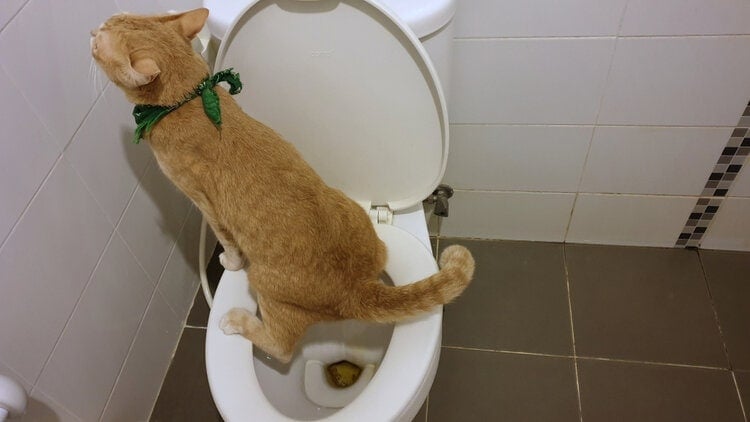The Risks of Flushing Cat Poop in Your Toilet - Preventive Measures
The Risks of Flushing Cat Poop in Your Toilet - Preventive Measures
Blog Article
How do you feel with regards to How to Dispose of Cat Poop and Litter Without Plastic Bags?

Introduction
As cat owners, it's important to bear in mind just how we take care of our feline buddies' waste. While it may seem convenient to flush cat poop down the toilet, this practice can have detrimental consequences for both the setting and human health.
Ecological Impact
Flushing cat poop introduces dangerous pathogens and bloodsuckers into the water supply, posing a substantial danger to aquatic ecological communities. These pollutants can adversely impact aquatic life and compromise water top quality.
Health and wellness Risks
Along with ecological worries, flushing cat waste can likewise present health and wellness dangers to people. Cat feces may contain Toxoplasma gondii, a bloodsucker that can create toxoplasmosis-- a potentially serious disease, particularly for pregnant females and individuals with weakened body immune systems.
Alternatives to Flushing
Luckily, there are safer and extra responsible means to take care of feline poop. Take into consideration the complying with choices:
1. Scoop and Dispose in Trash
The most typical method of throwing away cat poop is to scoop it into an eco-friendly bag and throw it in the trash. Make sure to make use of a dedicated litter inside story and take care of the waste promptly.
2. Use Biodegradable Litter
Select naturally degradable feline clutter made from products such as corn or wheat. These clutters are environmentally friendly and can be securely disposed of in the garbage.
3. Hide in the Yard
If you have a yard, take into consideration burying pet cat waste in a designated area away from veggie gardens and water resources. Be sure to dig deep adequate to avoid contamination of groundwater.
4. Mount a Pet Waste Disposal System
Purchase an animal waste disposal system especially designed for feline waste. These systems utilize enzymes to break down the waste, minimizing odor and environmental influence.
Conclusion
Responsible pet possession expands beyond offering food and sanctuary-- it also entails proper waste administration. By avoiding flushing feline poop down the bathroom and opting for alternate disposal approaches, we can minimize our environmental footprint and secure human wellness.
Why Can’t I Flush Cat Poop?
It Spreads a Parasite
Cats are frequently infected with a parasite called toxoplasma gondii. The parasite causes an infection called toxoplasmosis. It is usually harmless to cats. The parasite only uses cat poop as a host for its eggs. Otherwise, the cat’s immune system usually keeps the infection at low enough levels to maintain its own health. But it does not stop the develop of eggs. These eggs are tiny and surprisingly tough. They may survive for a year before they begin to grow. But that’s the problem.
Our wastewater system is not designed to deal with toxoplasmosis eggs. Instead, most eggs will flush from your toilet into sewers and wastewater management plants. After the sewage is treated for many other harmful things in it, it is typically released into local rivers, lakes, or oceans. Here, the toxoplasmosis eggs can find new hosts, including starfish, crabs, otters, and many other wildlife. For many, this is a significant risk to their health. Toxoplasmosis can also end up infecting water sources that are important for agriculture, which means our deer, pigs, and sheep can get infected too.
Is There Risk to Humans?
There can be a risk to human life from flushing cat poop down the toilet. If you do so, the parasites from your cat’s poop can end up in shellfish, game animals, or livestock. If this meat is then served raw or undercooked, the people who eat it can get sick.
In fact, according to the CDC, 40 million people in the United States are infected with toxoplasma gondii. They get it from exposure to infected seafood, or from some kind of cat poop contamination, like drinking from a stream that is contaminated or touching anything that has come into contact with cat poop. That includes just cleaning a cat litter box.
Most people who get infected with these parasites will not develop any symptoms. However, for pregnant women or for those with compromised immune systems, the parasite can cause severe health problems.
How to Handle Cat Poop
The best way to handle cat poop is actually to clean the box more often. The eggs that the parasite sheds will not become active until one to five days after the cat poops. That means that if you clean daily, you’re much less likely to come into direct contact with infectious eggs.
That said, always dispose of cat poop in the garbage and not down the toilet. Wash your hands before and after you clean the litter box, and bring the bag of poop right outside to your garbage bins.
https://trenchlesssolutionsusa.com/why-cant-i-flush-cat-poop/

I hope you enjoyed reading our section about Can You Flush Cat Poop Down The Toilet?. Thanks a lot for taking a few minutes to browse our post. Are you aware of someone else who is interested by the topic? Be sure promote it. We truly appreciate reading our article about Can You Flush Cat Poo or Litter Down the Toilet?.
Get Quote Now Report this page